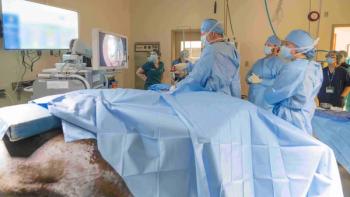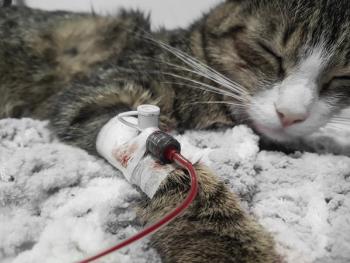
Surgery STAT: Preoperative assessment of surgical patients
A systematic approach can help ensure safety.
EDITOR'S NOTE: SurgerySTAT is a collaborative column between the American College of Veterinary Surgeons (ACVS) and DVM Newsmagazine.
Veterinary patients brought in for surgical procedures must be thoroughly evaluated, not only for their presenting complaints and diseases, but also for their suitability as candidates for anesthesia and subsequent surgery. Such an assessment is important for safe anesthetic and surgical practice.
A thorough evaluation may indicate that further care is necessary in the perioperative period—care that could minimize the risk of surgery and potential for postoperative complications. A good evaluation also helps surgeons determine whether surgery is warranted, as well as select the best procedure for a patient.
Dr. Abimbola O. Oshin
Moreover, it helps with prognostication, giving the clients a realistic expectation regarding the surgical intervention. In most cases, a thorough evaluation will also highlight other aspects of a patient's health that may need attention and future management.
All of the elements for a thorough preoperative assessment follow.
History taking
A complete history can be organized in the following manner for ease of remembrance: signalment, chief complaint, history of present illness, history of past illnesses (e.g., medical, surgical, vaccinations, medications), family history (if known), environmental history, diet history and body systems review.
Physical examination
Despite a natural inclination to concentrate on the presenting problems, veterinarians should focus the physical examination on evaluating the whole patient. Vital parameters and a general assessment of the patient, including a body condition score, should be recorded. Indeed, a systematic approach generally ensures that all body systems will be adequately evaluated.
Various formats have been described for performing a thorough physical examination. One format divides the evaluation process into examinations of the head and neck (eyes, ears, nose and throat), forequarters, thorax, abdomen and hindquarters. Another format emphasizes a body system approach, with division of examination into that of the cardiovascular, respiratory, alimentary, urogenital, lymphatic, endocrine, integumentary, musculoskeletal and neurologic systems. Note that a rectal examination is a valuable aspect of the examination and should always be performed.
Whichever system is used, it's imperative for each clinician to establish his or her own pattern so it becomes a routine progression, because haphazard examination always will be deficient in some category.
Of the procedures available for evaluating patients, the history and physical examination, described previously, are most effective in detecting important abnormalities. Problems missed at this stage are usually overlooked when more invasive or expensive diagnostic tests are performed.
After a complete history is taken and a physical examination is performed, it should be possible to assign a physical status to each patient as listed in Table 1. In emergencies in which a patient's status mandates an abbreviated examination, the physical status is qualified with an "E." To clarify, an emergency is defined as existing when delay in treatment would markedly increase the threat to the patient's life or body part. In such circumstances, only data for immediate initiation of treatment are collected, and the examination is then completed after the animal is stabilized.
Table 1: Physical status in surgical patients
Physical status is a major determinant but is not a direct predictor of anesthetic or surgical risk. Rather, the major purpose of discerning physical status is for comparing patients, selecting the most appropriate anesthetic protocol and determining whether a patient's status can be improved by postponing surgery in elective cases.
Laboratory data
Once a patient has been evaluated, clinical problems have been identified and a physical status has been assigned, it's then possible to select laboratory tests for further evaluation. The tests selected should be the minimum necessary to evaluate the presenting problem and its systemic manifestations, as well as to determine the significance of concurrent disease conditions detected during the initial examination. Minimum recommendations for laboratory testing based on a patient's physical status and expected duration of surgery are noted in Table 2.
Table 2: Recommendations for laboratory testing
Other diagnostic tests
These are tests that can be used to further characterize and investigate abnormalities detected when evaluating a surgical patient. Some of these tests also can help when planning surgical procedures. (When such investigations are considered essential but facilities do not exist, consider referring the patient.) Such tests will include some or all of the following:
- Coagulation studies
- Acid-base and electrolyte tests
- Organ function tests
- Hormone assays
- Plain and contrast radiography
- Electrocardiography
- Ultrasonography
- Magnetic resonance imaging
- Computed tomography
- Scintigraphy.
The most important factor in selecting tests for use in evaluating surgical patients is a sound understanding of the disease and its systemic effects. The procedure to be performed also influences the tests selected.
Determination of surgical risk
Most people know that surgical risk is a concept that weighs the relative benefits of surgery against the potential for harm. However, there's a much broader definition that also considers the surgeon's experience, procedure's invasiveness, potential for complications and quality of the patient's life, both with and without the recommended procedure. An overall risk is assigned once the patient has been thoroughly evaluated, and this is used in decisions about when, where and how to proceed with surgery and other treatment plans.
Surgical risk can determine prognosis as follows1 :
- Excellent: Little effect on patient, minimal potential for complications and a high probability the patient will return to normal after surgery.
- Good: High probability for a successful outcome, but the potential for complications as a result of the procedure are slightly higher than the previous category.
- Fair: One or more serious problems detected, or serious complications are possible but uncommon; recovery may be prolonged; or the animal may not return to its presurgical function.
- Guarded: The underlying disease or surgical procedure is associated with many or severe complications; recovery is expected to be prolonged; or the animal is unlikely to return to its presurgical function.
- Poor: Likelihood of death during or after the procedure is high; surgery is undertaken only if higher risk is expected if surgery is not performed (i.e., surgery is necessary to preserve life).
Client communication
The whole purpose of the preoperative evaluation of a patient is to enable the client and surgeon to make informed decisions and realize the potential for complications in the patient's care. A thorough patient evaluation will facilitate discussions related to:
- The disease
- Its course and prognosis both with and without treatment
- Options for treatment
- Recommended procedures
- Potential complications
- Aftercare
- An estimate of the immediate and follow-up cost.
Such an understanding is not only good for the surgeon-client relationship but will also enhance clients' compliance with recommendations for aftercare.
Dr. Abimbola Oshin is an ACVS board-certified small-animal surgeon and a member of its research committee. He is a partner at North Georgia Veterinary Specialists, Gainesville, Ga. He has an interest in all aspects of small-animal surgery.
REFERENCE
1. Modified from Slatter D: Textbook of small animal surgery. 3rd ed. St. Louis, Mo: Elsevier Saunders, 2003.
Newsletter
From exam room tips to practice management insights, get trusted veterinary news delivered straight to your inbox—subscribe to dvm360.




